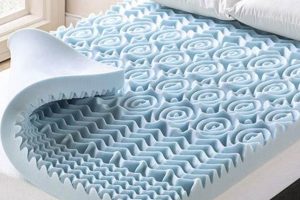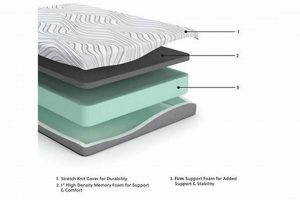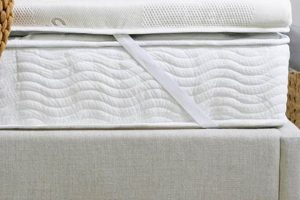The lifespan of a memory foam mattress is a significant consideration for consumers. This period refers to the duration for which the mattress maintains its support, comfort, and structural integrity, affecting sleep quality and overall value. For example, a well-maintained mattress might offer adequate support for seven to ten years.
Understanding the typical duration of usability is important for budgeting and planning for replacement. A longer lifespan translates to a better return on investment. Factors such as mattress density, material quality, and care practices all influence longevity. Historically, mattresses were often replaced due to sagging springs, but memory foam presents a different set of considerations regarding wear and tear.
The following sections will delve into the specific factors affecting mattress duration, signs indicating it is nearing the end of its useful period, and proactive measures to extend its service life. This will provide a comprehensive understanding for making informed decisions about mattress maintenance and replacement.
Tips to Maximize Mattress Lifespan
Extending the period a mattress provides optimal support requires consistent care and preventative measures. These tips outline practices to maintain structural integrity and comfort.
Tip 1: Rotate the Mattress Regularly: Consistent rotation, ideally every three to six months, ensures even weight distribution. This mitigates the development of sags and impressions in commonly used areas.
Tip 2: Use a Mattress Protector: A waterproof and breathable mattress protector safeguards against spills, stains, and dust mites. This barrier is essential for preventing internal damage and maintaining hygiene.
Tip 3: Provide Adequate Support: The foundation upon which the mattress rests is crucial. Ensure the bed frame offers firm, even support across the entire surface to prevent uneven wear and tear.
Tip 4: Avoid Excessive Weight or Pressure: Refrain from activities that place undue stress on specific areas of the mattress, such as prolonged sitting on the edge. This prevents premature degradation of the foam.
Tip 5: Air Out the Mattress Periodically: Remove bedding and allow the mattress to air out for several hours every few months. This helps release trapped moisture and odors, inhibiting mold and mildew growth.
Tip 6: Follow Manufacturer’s Instructions: Adhere to specific cleaning and care guidelines provided by the manufacturer. These recommendations are tailored to the mattress’s materials and construction.
Tip 7: Address Stains Promptly: Should spills occur, address them immediately using appropriate cleaning solutions. Prompt action prevents stains from setting and damaging the foam.
Implementing these practices consistently contributes significantly to prolonging mattress usability, maximizing comfort, and preserving its structural qualities.
The final section will provide guidance on recognizing when it’s time to consider replacing the mattress, regardless of preventative measures.
1. Material Density
The density of memory foam directly influences its durability and, consequently, its lifespan. Higher density indicates a greater quantity of material per unit volume, resulting in a more robust and resilient structure. This increased density translates to enhanced resistance to compression and deformation over time. A mattress composed of higher-density foam is less prone to sagging or developing body impressions, extending its period of usability. For example, a mattress with a density of 5 pounds per cubic foot will typically outlast one with a density of 3 pounds per cubic foot under similar usage conditions.
The correlation between density and longevity stems from the foam’s ability to recover its original shape after compression. Lower density foams tend to break down more quickly under consistent pressure, losing their ability to provide adequate support. This degradation manifests as a decrease in comfort and an increase in pressure points, leading to an unsatisfactory sleep experience. Furthermore, higher density foams often exhibit better temperature regulation properties, contributing to a more comfortable sleep environment and reducing the likelihood of moisture buildup that can degrade the material over time. This improved performance offers a tangible advantage, increasing the practical and functional duration of the mattress.
In summary, material density is a critical factor in determining how long a memory foam mattress will last. Higher density foams offer superior durability, resilience, and support, ultimately leading to a longer lifespan and a better return on investment. While other factors such as usage, care, and support structure also play a role, density remains a fundamental characteristic influencing the mattress’s overall performance and expected duration of optimal use. Understanding the implications of foam density empowers consumers to make informed decisions when selecting a mattress, ensuring that their investment provides lasting comfort and support.
2. Usage Frequency
The frequency with which a memory foam mattress is used directly impacts its lifespan. Increased usage leads to accelerated wear and tear on the foam, shortening the period it provides optimal support and comfort. Understanding the correlation between usage and longevity is crucial for estimating how long a memory foam mattress will last.
- Daily Occupancy Duration
The number of hours the mattress is occupied each day significantly influences its rate of degradation. Mattresses used for extended periods, such as in households where individuals spend considerable time in bed due to illness or lifestyle, experience greater compression and fatigue. This constant pressure reduces the foam’s ability to rebound to its original shape, leading to premature sagging and a decline in support.
- Number of Occupants
A mattress used by a single individual will generally last longer than the same mattress used by a couple or multiple occupants. Each person contributes to the overall weight and pressure exerted on the foam, accelerating its compression and breakdown. Shared mattresses experience a more concentrated and varied distribution of weight, leading to uneven wear and a reduction in structural integrity.
- Activity Level on the Mattress
Activities performed on the mattress, beyond sleeping, contribute to its wear. Actions such as sitting, reading, or watching television in bed create localized pressure points. These concentrated stresses can cause the foam to compress and deform in specific areas, resulting in uneven support and diminished comfort over time. Regular movement and adjustments in position can mitigate this effect to
some extent. - Frequency of Guest Use
While not a daily factor, the frequency of guest use impacts overall longevity. Infrequent but potentially intense periods of use, such as hosting visitors for extended stays, can contribute to additional wear and tear. Consistent guest use, particularly if guests have significantly different body weights or sleep habits, can accelerate the mattress’s degradation process, shortening its overall lifespan.
In summary, the intensity and pattern of usage directly influence the expected duration of a memory foam mattress. Higher frequency, multiple occupants, increased activity, and inconsistent guest use all contribute to accelerated wear and a reduced lifespan. A mattress experiencing minimal and consistent use by a single individual will invariably last longer than one subjected to frequent and varied stresses. These considerations are essential for consumers to accurately assess how long a memory foam mattress will last in their specific circumstances.
3. Support Structure
The support structure underlying a memory foam mattress significantly influences its durability and overall lifespan. A properly designed and maintained support system distributes weight evenly, preventing premature sagging and extending the period it provides adequate comfort. The absence of suitable support compromises the mattress’s structural integrity.
- Foundation Type
The foundation supporting the mattress plays a crucial role. Options include solid platforms, slatted frames, and box springs. Solid platforms provide the most uniform support, minimizing stress on the foam. Slatted frames must have closely spaced, sturdy slats to prevent sagging between them. Older box springs, particularly those with worn coils, may offer inadequate or uneven support, accelerating wear and tear. A foundation that fails to uniformly support the mattress will lead to localized compression and reduce its lifespan.
- Frame Quality
The quality of the bed frame itself is essential. A flimsy or poorly constructed frame can warp or bend, resulting in uneven support for the mattress. A frame with a center support beam is particularly important for larger mattresses, preventing sagging in the middle. Inadequate frame strength contributes to mattress deformation and a shortened lifespan.
- Slat Spacing and Strength
For slatted bed frames, the spacing between slats and their individual strength are critical. Slats spaced too far apart allow the mattress to sag between them, creating pressure points and accelerating wear. Weak slats can break or bend over time, further compromising support. Optimally, slats should be no more than a few inches apart and constructed of durable wood or metal.
- Level Surface
The surface upon which the bed frame rests must be level. An uneven floor can cause the frame to twist or warp, leading to uneven support for the mattress. This unevenness results in localized stress and premature wear. Ensuring the frame sits on a level surface is a fundamental step in maximizing mattress longevity.
In conclusion, the support structure is integral to preserving the integrity and extending the lifespan of a memory foam mattress. A robust foundation, a high-quality frame, appropriate slat spacing, and a level surface are all essential components. Inadequate support leads to premature wear, sagging, and a diminished sleep experience, ultimately shortening the duration the mattress provides optimal performance.
4. Care practices
The diligence with which a memory foam mattress is maintained directly influences its longevity. Consistent and appropriate care practices mitigate wear and tear, preserving its structural integrity and extending the period it provides optimal comfort.
- Regular Cleaning and Vacuuming
Consistent removal of dust mites, allergens, and debris from the mattress surface prevents the breakdown of foam fibers. Vacuuming with an upholstery attachment eliminates surface contaminants that contribute to material degradation. Failure to clean regularly allows these particles to accumulate, fostering an environment conducive to premature wear.
- Use of a Mattress Protector
A high-quality mattress protector serves as a barrier against spills, stains, and bodily fluids. These contaminants can penetrate the foam, causing irreversible damage and fostering mold or mildew growth. A protector safeguards the mattress core, preventing these detrimental effects and prolonging its lifespan.
- Rotation and Flipping (if applicable)
Rotating the mattress, and flipping it if the design permits, ensures even weight distribution. This practice prevents the development of body impressions and localized sagging. Uneven wear can significantly reduce the mattress’s comfort and support capabilities, diminishing its usable lifespan. Rotating the mattress addresses this issue.
- Proper Support System Maintenance
Ensuring the bed frame and foundation provide adequate and uniform support is crucial. A sagging or inadequate support system places undue stress on the mattress, leading to premature deformation. Regular inspection and maintenance of the support system prevent this detrimental effect.
The consistent application of appropriate care practices directly correlates with the duration a memory foam mattress retains its desired characteristics. Neglecting these practices accelerates wear and tear, shortening the period it provides adequate support and comfort. Adhering to recommended care guidelines is essential for maximizing its lifespan and maintaining a hygienic sleep environment.
5. Body weight
Body weight exerts a significant influence on the lifespan of a memory foam mattress. The consistent pressure exerted by an individual’s mass directly impacts the foam’s compression rate and overall durability, thereby affecting its usability period.
- Compression Rate
Individuals with higher body weights exert greater compressive force on the mattress, leading to a faster compression rate of the memory foam. This accelerated compression reduces the foam’s ability to recover its original shape, resulting in sagging and a loss of support over time. The rate of degradation is directly proportional to the force applied.
- Localized Pressure Points
Increased body weight concentrates pressure on specific areas of the mattress, such as the hips and shoulders. These localized pressure points experience greater compression than other areas, leading to uneven wear and the development of body impressions. The disparity in pressure distribution contributes to a reduction in overall comfort and support.
- Foam Density Requirements
Higher body weights necessitate mattresses with greater foam density. Denser foams offer enhanced resistance to compression and provide more substantial support. A mattress with insufficient density will quickly degrade under the pressure of a heavier individual, sig
nificantly shortening its lifespan. - Material Fatigue
The constant compression and decompression cycles experienced by the memory foam contribute to material fatigue. Over time, the foam loses its elasticity and ability to rebound, resulting in a permanent deformation. Higher body weights accelerate this process, leading to a more rapid decline in mattress performance.
In summary, body weight is a critical factor determining the lifespan of a memory foam mattress. Increased weight accelerates compression, concentrates pressure, necessitates higher density foams, and contributes to material fatigue. These factors collectively reduce the period the mattress provides optimal support and comfort.
6. Manufacturing quality
Manufacturing quality serves as a foundational element in determining the durability and lifespan of a memory foam mattress. Adherence to stringent quality control measures throughout the production process directly correlates with the product’s ability to withstand prolonged use and maintain its intended support characteristics.
- Foam Composition and Formulation
The precise chemical formulation of the memory foam significantly impacts its resistance to degradation. High-quality manufacturers utilize proprietary blends and precise mixing techniques to ensure optimal foam density, resilience, and resistance to heat and moisture. Inconsistent or substandard formulations can result in premature breakdown, off-gassing issues, and a reduced lifespan. For instance, a mattress produced with inferior foam may exhibit noticeable sagging within a few years, whereas one crafted with superior materials maintains its shape and support for a significantly longer duration.
- Construction Techniques and Layer Integration
The manner in which the various layers of a mattress are assembled and bonded together directly influences its structural integrity. Quality manufacturers employ advanced bonding agents and precise layering techniques to prevent delamination and ensure uniform weight distribution. Poorly constructed mattresses may experience separation of layers, leading to uneven support and a shortened lifespan. Proper construction minimizes internal stress and maximizes the mattress’s ability to withstand long-term use.
- Quality Control and Testing Procedures
Rigorous quality control measures throughout the manufacturing process are essential for identifying and rectifying defects. Comprehensive testing procedures, including compression tests, durability assessments, and chemical emission analyses, ensure that the mattress meets stringent performance standards. Manufacturers committed to quality employ these processes to detect and eliminate substandard products, ensuring that only mattresses meeting the highest standards reach consumers. The absence of adequate quality control can result in the proliferation of mattresses prone to premature failure.
- Materials Sourcing and Supplier Relationships
The quality of raw materials sourced from suppliers directly impacts the final product. Reputable manufacturers establish strong relationships with reliable suppliers who adhere to stringent quality control standards. Using certified foams, fabrics, and adhesives ensures consistency and minimizes the risk of defects. Conversely, manufacturers who prioritize cost over quality may source substandard materials, resulting in a product with a diminished lifespan.
The multifaceted nature of manufacturing quality underscores its critical role in determining how long a memory foam mattress will last. From the precise formulation of the foam to the meticulous assembly and rigorous testing procedures, each aspect contributes to the mattress’s overall durability and longevity. Consumers prioritizing a long-lasting investment should prioritize mattresses from manufacturers renowned for their commitment to quality and adherence to industry best practices.
Frequently Asked Questions
The following addresses common inquiries concerning the durability and expected use period of memory foam mattresses. Information is intended to provide clarity regarding factors influencing longevity and optimal usage.
Question 1: What is the average expected duration a memory foam mattress remains usable?
A memory foam mattress typically provides adequate support and comfort for seven to ten years, contingent upon factors such as foam density, usage patterns, and care practices. High-density foams used by a single sleeper and maintained properly may exceed this range, while lower-density foams subjected to heavy use may require replacement sooner.
Question 2: What are the primary indicators a memory foam mattress requires replacement?
Key indicators include visible sagging or body impressions, a noticeable decline in support leading to discomfort, increased back or joint pain upon waking, and the presence of persistent odors or allergens that cannot be eliminated through cleaning. These signs suggest the foam’s structural integrity has been compromised.
Question 3: Does the density of the memory foam significantly impact its lifespan?
Yes, foam density is a crucial determinant. Higher-density foams exhibit greater resistance to compression and deformation, resulting in a longer usable period. Mattresses with densities of 5 pounds per cubic foot or higher generally offer superior durability compared to lower-density options.
Question 4: How do sleeping habits influence mattress longevity?
Sleeping habits, including the number of occupants and their movements during sleep, directly affect wear and tear. A mattress used by multiple individuals or subjected to frequent tossing and turning will degrade more rapidly than one used by a single, relatively still sleeper. Regular rotation can mitigate some of these effects.
Question 5: Can a mattress protector substantially extend the lifespan of a memory foam mattress?
A quality mattress protector serves as a critical barrier against spills, stains, and dust mites, all of which can compromise the integrity of the foam. By preventing these contaminants from penetrating the mattress core, a protector significantly prolongs its lifespan and maintains a hygienic sleep environment.
Question 6: What role does the bed frame or foundation play in mattress longevity?
The bed frame and foundation provide essential support for the mattress. An inadequate or sagging support system places undue stress on the foam, leading to uneven wear and a shortened lifespan. A solid platform or a slatted frame with closely spaced, sturdy slats is recommended.
Understanding the interplay of these factors allows for a more accurate assessment of the expected use period and aids in making informed decisions regarding maintenance and replacement.
The following section will offer guidance on extending the lifespan through proper maintenance and care.
Determining Mattress Lifespan
The preceding exploration has detailed the multifaceted nature of mattress longevity, emphasizing factors such as foam density, usage patterns, support structure, and care practices. Understanding these elements allows for a more accurate assessment of the period a mattress will provide optimal support and comfort. Ignoring these considerations may lead to premature replacement and unnecessary expenditure.
Ultimately, informed decision
s regarding mattress selection, maintenance, and replacement are essential for maximizing value and ensuring restorative sleep. While the variables discussed influence the practical duration of use, regular assessment of its condition remains critical for achieving sustained comfort and promoting long-term well-being.


![Best Memory Foam Mattress Queen Walmart [Deals!] Organic & Natural Mattress Buyer’s Guide: Non-Toxic Sleep Solutions Best Memory Foam Mattress Queen Walmart [Deals!] | Organic & Natural Mattress Buyer’s Guide: Non-Toxic Sleep Solutions](https://mattressworldpa.com/wp-content/uploads/2025/07/th-3980-300x200.jpg)


![Best Memory Foam King Size Mattress [Guide & Reviews] Organic & Natural Mattress Buyer’s Guide: Non-Toxic Sleep Solutions Best Memory Foam King Size Mattress [Guide & Reviews] | Organic & Natural Mattress Buyer’s Guide: Non-Toxic Sleep Solutions](https://mattressworldpa.com/wp-content/uploads/2025/07/th-3977-300x200.jpg)

